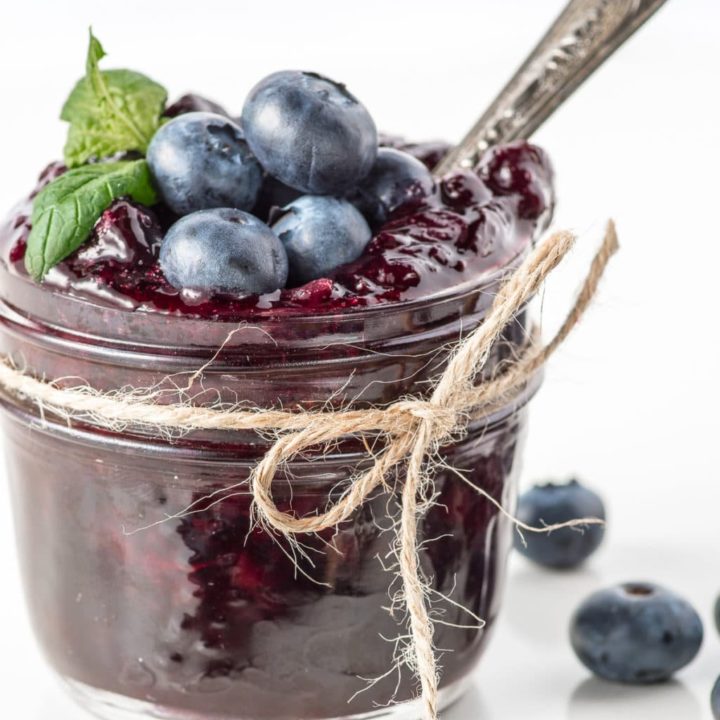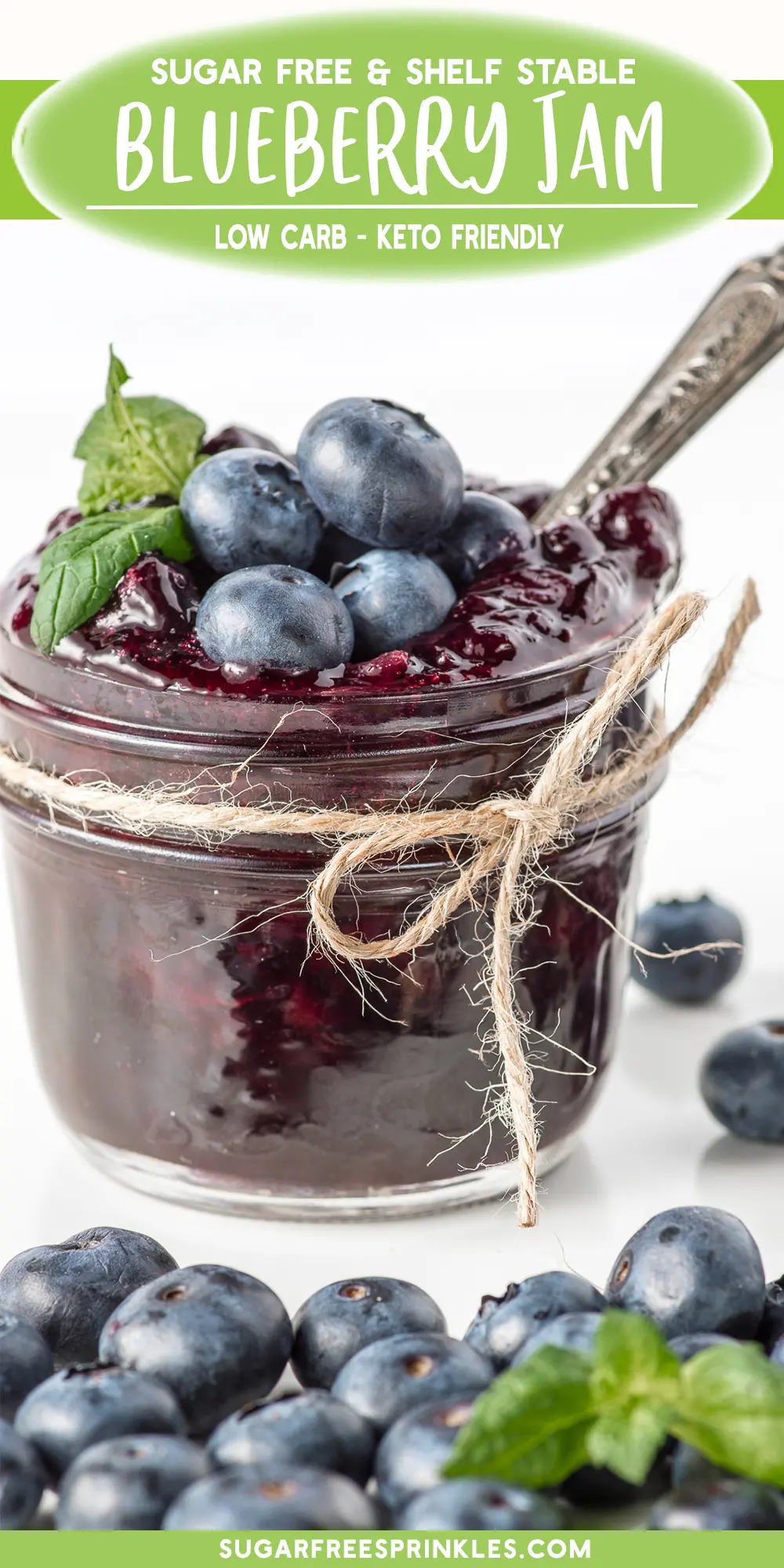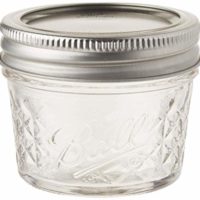Blueberry season is just around the corner. Berry season, in general, is one of my favorite times of the year. I LOVE it when the garden starts to produce, and it’s time to start picking berries. Also, I love jam-making season, and even though I don’t eat sugar anymore and watch my carbs, I can still make and have my favorite sugar-free blueberry jam. The kicker is that it’s just as good as any jam you will find on a shelf in a store.
There is no added sugar in this recipe, only the natural sugar from the fruit.
Why blueberry jam is always a good idea
Homemade blueberry jam is a great pantry staple to have stocked up on your shelves.
It’s great on pancakes and waffles, stirred into low carb granola, smeared on a low carb biscuit, or used as a topping on cheesecake squares.
Tarts, bars, squares, cookies, ice cream – you name it, and this little wonder can do it all. A little dab will do you, but boy does it make recipes pop. At only 1.7 net carbs per tablespoon, it’s a great way to get a pop of blueberry flavor without blowing your carb counts for the day.
Not all pectins have added sugar.
Ok, so now let us talk about the pectin problem.
Pectin gets a bad wrap. You know what the first ingredient is on the back of a Certo “low sugar” pectin. Sugar.
Alrighty then. I checked the back of several low sugar pectins and each one either had sugar or dextrose listed as the first ingredient.
Ok, so what do we do?
Well, I found this great product called Pomona’s Universal Pectin, and it’s the perfect solution.
This recipe post isn’t a sponsored post. I legitimately LOVE this product and paid for it out of my pocket. It amazed the hell out of me while I was making and testing jam recipes. It’s sugar-free, vegan, non-GMO, and works PERFECTLY! I have had a blast the last few weeks testing and making jams with this product.
No sugar required either! You do need to use a sweetener.
Stevia, xylitol, erythritol, monk fruit, allulose – it doesn’t matter, it will work. I tested ALL of them to see what sugar replacement would work best, and they all worked exceptionally well.
If you are concerned about the carb content in the actual pectin, don’t.
One teaspoon (3 grams) of Pomona’s Universal Pectin contains:
10.2 Total Calories
2.55 grams carbohydrate (from soluble fiber)
2.5 grams of soluble fiber
Since we’re only adding 3 tsp to the entire recipe ( over 80 servings ), the carb additions are negligible.
Are you as excited about this product as I am?!
Pomona’s 100% pectin
So if you have canned jam before this process is a tiny bit different.
The package of pectin also comes with a small packet of calcium powder.
There are two types of pectins – pectins that require sugar to gel, and pectins that need calcium to gel. There is a whole scientific explanation on Pomona’s website if you’re interested in reading all about it.
The calcium powder gets mixed into a small jar of water (lasts forever refrigerated). The calcium water is what gets added to your jam recipes, usually a tsp or two at a time.
SO easy.
You can find Pomona’s pectin on Amazon or in health food stores. I paid a little over $8.00 Canadian for a box. I balked at the price but did not realize that one box of Pomona’s Universal Pectin will make up to 20 half-pints (8 ounces) jars.
And you know what… with commercial low sugar jams priced out to lunch, it’s still way cheaper to make your own.
Working with Pomona’s Universal pectin
I found working with this pectin much easier to use than regular pectin. It seemed much more forgiving. If the jam didn’t gel to my requirements, I could add more calcium water, and it would thicken.
If I added my pectin and sweetener, I could always add more sweetener and continue to process without over thickening the jam. Having the option to reprocess was great because I wanted to make sure my jam was sweet enough, but I didn’t want to over sweeten at the start.
Additionally, If you have jars of jam that don’t quite set after they are cooled, you can reprocess them and add either more pectin or more calcium water to get the gel to thicken.
The instructions come in the box, and they are super easy to follow. Pomona’s also has a fantastic website with all kinds of directions and base recipes for you to work with including instructions for developing your own recipes.
- Quick note: Use filtered water in your recipes. If you have hard water (which tends to lean heavy on the calcium already), they will thicken more than you want them to – so be mindful that your home tap water can play a part in how thick your jam gels.
What are the best sweeteners for this low carb Blueberry jam recipe?
I tested them all! My kitchen will be forever sticky after this jamathon!
By far the sugar-free blueberry jam made with Allulose was the best. It had a sticky, gooey texture that commercially bottled jams are known for, and had the best taste. It straight up tasted like jam. By far, my favorite.
Erythritol did tend to turn grainy when cold, as erythritol tends to do. If you warmed the jam up, it was perfect. So if you want to use erythritol know that graining up when cold will happen.
I also tested my favorite sweetener, So Nourished monk fruit erythritol blend, and it did grain up a tiny bit when cold but not as much as straight-up erythritol in the recipe.
Xylitol was GREAT, but it does add additional carbs, so not my favorite for that reason.
Truvia, Stevia, and Swerve worked fine, but I find they have an aftertaste for me, but that’s personal. If you like Truvia, or stevia, or Swerve, absolutely use them. The jam gelled beautifully, and the fruit held the color and texture.
****If you use Xylitol, remember that it is poisonous to dogs and cats! ****
If you don’t read anything else, please read these essential canning tips.
Ok, so this sugar-free blueberry jam requires a water bath canning.
There are a few safety precautions you need to take that are not optional. Since this jam is going up on the shelf, it requires a full 10-minute full boil canning bath to preserve.
- DO NOT skip the lemon juice. I usually say fresh lemon juice at every opportunity, but canning is different. Use bottled lemon juice. Fresh lemons vary in acidity you want to make sure you get your acidity level correct and using bottled lemon juice will ensure you’re adding the right amount.
- Flipping the jam bottles over and letting them rest will NOT work for this jam. Please don’t do this. This recipe requires a full 10-minute rolling boil in a canning bath to ensure the jam is safe.
- Do not use a jam bottle larger that 500ML (2 cups).
- When you pull your sugar-free blueberry jam bottles from the canning bath, leave them rest for 24 hours without moving them, or tilting them. Let them set.
- Any jars that did not seal can be processed again.
Storage & uses for your sugar-free blueberry jam.
This sugar-free blueberry jam is shelf-stable for up to a year if stored in a cool dark place. Once opened the blueberry jam will last up to 3 weeks inside the refrigerator.
It’s a perfect jam to go with a low carb scone or biscuit, or as fruit topping for, well, for any dessert. I put it on top of my blueberry cheesecake squares, and love a spoonful or two on my low carb granola. But you could use it to fill tart crusts, or use a filling for muffins, cakes or even cheesecakes. It’s a pretty versatile little ingredient to have on hand in a pantry.
I love making my jams because I like to control what goes in them. With this little recipe, I feel confident that I have good healthy ingredients and a delicious jam.
I hope you enjoy it!
Looking for More Sugar-Free Jam Recipes?
Check out some of our other popular sugar free and low carb jams:
- Low Carb Blackberry Jam
- Keto Raspberry Jam
- Sugar Free Cherry Jam
- Sugar Free Strawberry Rhubarb Jam
- Keto Lemon Curd
- Blueberry Freezer Jam

How to Make a Shelf Stable Sugar Free Blue Berry Jam ( plus it's low carb!)
Ingredients
- 6 cups blueberries
- 1/4 cup lemon juice
- 2 cups allulose
- 3 tsp Pomona's Universal Pectin
- 3 tsp calcium water (provided in the pectin box)
- 1/4 tsp cinnamon (optional)
- 1 tsp vanilla (optional)
Instructions
- Wash jars, bands, and lids. Place jam jars in water bath canner filled 1/2 way with water. Bring water to a boil. Turn off the burner and leave jars in canner until ready to use
- Place lids in water in a small saucepan and heat until water simmers. keep lids in warm water until ready to use.
- If using fresh blueberries, clean & destem before adding to a large saucepan. If using frozen measure and just pour right in.
- Add lemon juice and calcium water and blend in well.
- In a bowl add allulose and pectin and blend well.
- Heat the blueberries and as they start to soften, mash with the back of a fork, or use a potato masher. I like to leave a few whole berries in my jam, but mash to the consistency that you like. Bring berries to a boil.
- Add pectin-sweetener mixture, continuing to mix for 1 to 2 minutes to dissolve the pectin while the jam comes back up to a boil. Boil for 1 full minute once the jam reaches the boiling stage.
- Fill jam jars to ¼” to the top. Clean rims with a clean cloth. Add lids.
- Add jars to the water bath canner when the water in the canner reaches a full boil. Boil 10 full minutes (add 1 minute more for every 1,000 ft. above sea level).
- Remove from water. Let jars cool undisturbed for 24 hours.
- Test for seal, if a jar did not seal, you can reprocess it again in the canner for 10 full minutes, or add that jar to the refrigerator for up to 3 weeks.
Notes
This recipe was adapted from https://pomonapectin.com/recipes/blueberry-jam/ and created and tested specifically using Allulose.
Recommended Products
As an Amazon Associate and member of other affiliate programs, I earn from qualifying purchases.
Nutrition Information:
Yield: 80 Serving Size: 1 TBSAmount Per Serving: Calories: 7Total Fat: 0gSaturated Fat: 0gTrans Fat: 0gUnsaturated Fat: 0gCholesterol: 0mgSodium: 1mgCarbohydrates: 2gNet Carbohydrates: 1.7gFiber: .3gSugar: 1gProtein: 0g
Nutritional information for the recipe is provided as a courtesy and is approximate only. We cannot guarantee the accuracy of the nutritional information given for any recipe on this site. Erythritol carbs (and sugar alcohols) are not included in carb counts as it has been shown not to impact blood sugar. Net carbs are the total carbs minus fibre.













